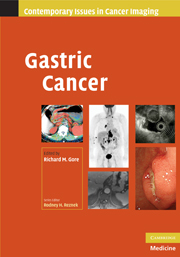Book contents
- Frontmatter
- Contents
- List of contributors
- Series Foreword
- Preface to Gastric Cancer
- 1 Epidemiology of gastric cancer
- 2 Pathology of gastric cancer
- 3 Endoscopy in the diagnosis and treatment of gastric cancer
- 4 Upper gastrointestinal series in the diagnosis of gastric cancer
- 5 Surgical management of gastric cancer
- 6 Systemic therapy for gastric cancer
- 7 MDCT, EUS, PET/CT, and MRI in the management of patients with gastric neoplasms
- 8 Gastric cancer: current trends and future opportunities
- Index
- References
1 - Epidemiology of gastric cancer
Published online by Cambridge University Press: 31 March 2010
- Frontmatter
- Contents
- List of contributors
- Series Foreword
- Preface to Gastric Cancer
- 1 Epidemiology of gastric cancer
- 2 Pathology of gastric cancer
- 3 Endoscopy in the diagnosis and treatment of gastric cancer
- 4 Upper gastrointestinal series in the diagnosis of gastric cancer
- 5 Surgical management of gastric cancer
- 6 Systemic therapy for gastric cancer
- 7 MDCT, EUS, PET/CT, and MRI in the management of patients with gastric neoplasms
- 8 Gastric cancer: current trends and future opportunities
- Index
- References
Summary
Introduction
Although the incidence and mortality rate of gastric cancer are declining in the United States and Great Britain (Figures 1.1 and1.2), gastric carcinoma remains the fourth most common cancer in the world and is second only to lung cancer in terms of worldwide cancer deaths (Figures 1.3 and 1.4).The development of gastric cancer is a multifactorial process, and many conditions influence the likelihood of occurrence. An understanding of the disease process in these patients is important for the assessment of risk and prognosis. In this chapter, the epidemiologic factors of gastric cancer, including its incidence, mortality, pathogenesis, and risk factors, are discussed.
Incidence and mortality
In developing countries, there is a high incidence of gastric cancer, and more than 990,000 cases occur worldwide each year based on 2008 statistics. However, in the United States, gastric cancer represents only approximately 1.5% of an estimated 1.44 million new cancer cases each year. Th ere were 22,000 new cases in the United States in 2008. Despite the decreasing incidence of gastric carcinoma from a previous rate of 35/100 000 cases in 1930 to 4/100 000 cases in 2003, it carries a relatively high mortality rate when compared to other cancers: 2.96 and 5.70/100,000 for women and men, respectively. Not only is the incidence higher in men, so trends the death rate. However, the mortality rate of gastric cancer in the United States has decreased by 26% and 35% since 1990 in females and males, respectively.
- Type
- Chapter
- Information
- Gastric Cancer , pp. 1 - 21Publisher: Cambridge University PressPrint publication year: 2009

